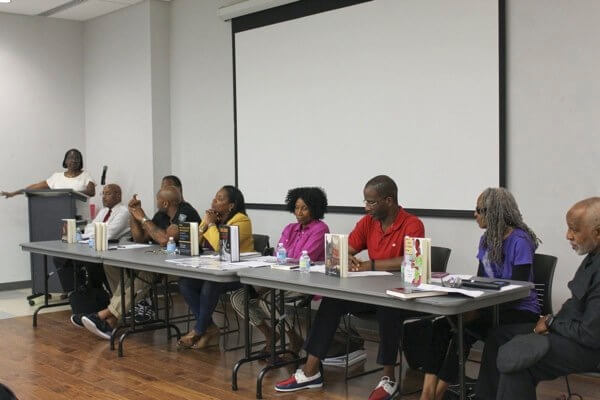By Naeisha Rose
A panel discussion on who ends up behind bars was held at the Cambria Heights Library and included prison reform advocates, some of whom were formerly incarcerated.
Moderating the panel was social justice artist Wanda Best, who had her artwork featured at the Jamaica Center for Arts and Learning art show earlier this month.
In her painting, entitled “Prison Population,” a white figure is huddled behind bars next to five black figures and two brown.
“For every one white person there are five African-Americans and two Hispanics in the United States jails,” Best said at the Saturday event.
The conversation centered on the difference between hyper-incarceration and mass incarceration.
“Hyper-incarceration is when certain groups are targeted,” Best said. “People of color, people between the ages of 18 to 22, people from inner cities or in rural areas are who populate the prison system.”
Best believes that mass incarceration does not exist because not every single race or income bracket is equally represented in the United States’ prison population.
Two of the panelists were Joseph “Jazz” Hayden and Herman Baron.
Jazz, a former prisoner at Attica Correctional Facility who was acquitted of trumped-up attempted murder charges five days before the infamous Sept. 9, 1971, riot at the prison, understood what it was like to have a bull’s eye on his back and agreed with Best’s definitions.
Jazz became a black activist during the anti-Vietnam war movement. Many pro-black and young far leftwing activists, including members of the Black Panther Party, the Weathermen, the Revolutionary Youth Movement, and Students for a Democratic Society, were shuffled into the prison population for voicing their displeasure with the government, according to Jazz.
“All of these people were causing a problem here in America,” Jazz said. “The government’s response was to push back by cracking down on all of these movements out there and they locked us up, then swept us off to Attica.”
The inhumane conditions — like only being able to shower once a week, poor food, lack of supplies for hygiene and prison guard brutality against the former demonstrators — led to the “perfect soufflé” of what would later become the Attica Prison Riots, according to Jazz.
Herman Baron, who was in the U.S. Marine Corps Reserve, had a different experience with the prison system. He did not realize the difference between mass incarceration and hyper-incarceration until he spent more than 14 years at several federal correctional institutions across the country on drug charges.
After getting kicked out of the Marine Corps, Baron got mixed up with the wrong crowd in Brooklyn and started selling crack cocaine. He was arrested and sentenced to 20 years in prison. The Manhattan Community College alum spent his time in prison teaching inmates life skills to keep them from falling into recidivism and was granted clemency by former President Barack Obama in January.
“I take full responsibility for my actions,” said Baron, 43.
While in prison, he studied drug laws and realized he was received much harsher punishment compared to others for a similar crime.
“White men my age were charged with 10 years, or 12 years and I got 20,” Baron said. “Fifty grams of crack will get you 10 years, but most white people sell cocaine and for the same amount of years they would have to sell 500 grams. That right there is a disparity.”
Baron believes the bias, in terms of how long blacks are incarcerated in comparison to whites, speaks for itself.
“The system is rigged against us,” Baron said. “There is something wrong when we make up 12 percent of the country’s population, but over 50 percent of the prison population. There is something wrong with that picture.”
Baron is now a painter, poet, published author and motivational speaker.
Reach reporter Naeisha Rose by e-mail at nrose

































